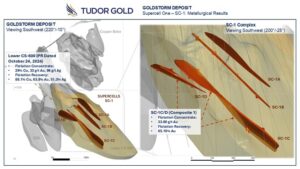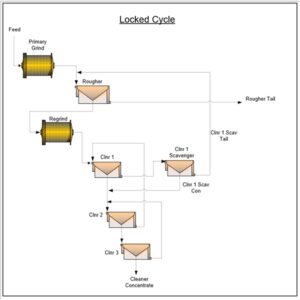
The Prospector News
Tudor Gold Announces Positive Results From Initial Metallurgical Testing For The High-Grade Gold Supercell-One Complex Within The Goldstorm Deposit, At Treaty Creek, Located In The Heart Of The Golden Triangle, British Columbia
You have opened a direct link to the current edition PDF
Open PDF CloseTudor Gold Announces Positive Results From Initial Metallurgical Testing For The High-Grade Gold Supercell-One Complex Within The Goldstorm Deposit, At Treaty Creek, Located In The Heart Of The Golden Triangle, British Columbia
Tudor Gold Corp. (TSX-V: TUD) (Frankfurt: H56) (OTC: TDRRF) is pleased to announce initial results from ongoing metallurgical test work on the high-grade gold Supercell-One Complex (SC-1), located at the Treaty Creek Project situated within the Golden Triangle of British Columbia. The initial metallurgical results of the SC-1 composites follow the highly successful initial metallurgical results of the CS-600 Sub-Domain which were released in the company’s press release dated October 24, 2024 and highlighted in this press release below.
The SC-1 Complex was discovered during the 2024 drill campaign. This discovery demonstrates significant additional economic potential for the Treaty Creek Project. The SC-1 Complex is peripheral to the CS-600 copper-gold domain and is best described as a series of sub-parallel, intermediate- to low-sulphidation breccia structures that overprint the Goldstorm gold-copper-silver porphyry deposit. The structures are superimposed over and cut through the CS-600 copper-gold domain as a late-stage event. The SC-1 Complex is comprised of four distinct breccia structures: SC-1A, SC-1B, SC-1C and SC-1D. While SC-1B carries high-grade copper and silver mineralization, in addition to gold mineralization, it is the only structure that is considered polymetallic. The other three structures, SC-1A, SC-1C and SC-1D are all high-grade gold systems.
Highlights from the results of the two lowermost structures, SC-1C and SC-1D include:
- Flotation recoveries of up to 85.1% gold were achieved.
- Flotation testing confirmed that a salable concentrate from the SC-1C and SC-1D auriferous quartz-pyrite breccia structures produced a concentrategrade of 33.6 g/t gold.
Results from the SC-1C and SC-1D structures complement the recently reported metallurgical testing on the Lower CS-600 Sub-Domain, which returned:
- Flotation recoveries within the Lower CS-600 sub-domain returned up to 88.1% copper, 63.8% gold, and 51.3% silver.
- Flotation testing confirmed that a high-grade copper concentrate with significant quantities of gold can be produced from the Lower CS-600 Sub-Domain that exceeds 29% copper with significant gold and silver grades of 33 g/t and 96 g/t, respectively.
The samples reported in this press release are from the 2024 drill campaign and were selected from representative composite samples of the SC-1C and SC-1D structures. These sample locations and compositions are outlined below in Figure 1.
SUPERCELL-ONE ZONE – GOLDSTORM DEPOSIT
Figure 1: Supercell-One Metallurgical Results Image
Commenting on the results, Ken Konkin, President & CEO of Tudor Gold stated, ” We are very pleased with our preliminary metallurgical test results for two of the SC-1 structures that we believe hold the greatest potential for making a substantial economic impact on the Project. This marks a significant step forward in advancing the exploration and development of the high-grade-gold complex that may lead to the ‘mine within a mine concept’ and represents a pivotal point generating a rejuvenation of a very significant exploration target that could require a much smaller capital cost as a starter area for the Treaty Creek Project. SC-1C is the largest structure, spanning up to 800 meters in length by 400 meters in depth, that we believe can be effectively processed using standard metallurgical technology. All structures are open in all directions. Most importantly, these initial findings demonstrate that a viable gold concentrate could be generated from the largest breccia structures within the Supercell Complex. Additionally, the original hole that intersected SC-1C (GS-22-134) contained 17 grains of fine-grained visible gold, observed over 4.5 meters that averaged 20.61 g/t Au. Of importance to note, was that the values in GS-22-134 had very consistent gold grades with no apparent ‘nugget effect’ that can often occur within these types of systems. Given that we see visible gold in the core, a gravity-flotation system is currently the best choice of beneficiation. However, Tudor’s goal is to optimize and enhance recoveries, and to increase concentrate grades through flotation technology. Further metallurgical studies are also underway on the copper-gold-dominant CS-600 Domain, for which initial metallurgical results were announced on October 24, 2024. The metallurgical study showed that material extracted from the CS-600 copper-gold domain can be processed with conventional flotation techniques to produce a high-quality copper-gold concentrate. Looking forward, the focus in the near term is to continue to investigate the SC-1C and SC-1D mineralized horizons, given that these appear to have the best grade, width and continuity, to develop a multi-million ounce complex analogous to that of the Valley of Kings Deposit at Brucejack Lake. The company is working on permitting for an exploration ramp to best delineate the Supercell structures and test for additional mineralized structures along that vast un-tested upper contact area of the CS-600 Domain.”
Initial test work reported in this press release was carried out on material from two structures (SC-1C and SC-1D) at the recently discovered SC-1 Complex, which is within the Goldstorm Deposit at the Treaty Creek Project. Only fresh, non-oxidized, mineralized material was taken from SC-1D and SC-1C and blended into a composite sample. Previously collected high-grade samples were not tested in the preliminary tests, ensuring that the test samples were not compromised by oxide minerals. The two Supercell structures were blended as one composite and were subjected to mineralogy, gravity (Knelson/Mozley), whole ore cyanidation, whole ore pressure oxidation (“POX”) treatment, as well as batch and locked cycle flotation testing. Initial results demonstrated flotation as the most economical and simple method to recover gold and copper mineralization. Head assays of the two composites are listed below in Table 1.
Table 1. Initial Head Assay Results from Composite Sample SC1-C and D
From the SC1-C and SC-1D composites no gravity-recoverable gold was detected in these particlar samples. A significant portion of gold (42%) was found to be locked in sulphides. The cyanide leach at a primary grind of 75 microns recovered 46.8% gold. Further testwork at a finer grind is currently underway. Whole ore POX performed well, yielding over 91% gold extraction after 24 hours.
The use of flotation processes demonstrated very efficient gold recoverability, achieving impressive recovery rates of 91-93% at the rougher stage with a primary grind of 75 microns. A coarser primary grind of 125 microns was also tested with no negative effects on the recovery. Locked cycle testing yielded 85% overall recovery, producing a saleable concentrate with gold content of 33.6 g/t. This translates to a substantial five times increase in gold concentration with a 17% mass pull. However, the cleaner concentrate contains some deleterious elements such as 0.8% arsenic, 0.3% antimony, 0.005% bismuth, and 0.04% mercury. It is suspected some of the deleterious elements are tied up in the tennanite/tetrahedrite minerals. Further flotation test work is currently underway to improve overall concentrate quality.
Locked Cycle Metallurgical Test Work and Results SC1-C and D
Locked Cycle Test Flowsheet SC1-C and D
Figure 2: Source: SGS Canada (2025)
The metallurgical program was carried out by SGS of Vancouver, B.C., which has been selected to conduct further mineralogical assessment of the Goldstorm sample material. The metallurgical and mineralogical work was conducted under the supervision of Travis O’Farrell, P. Eng of Fuse Advisors., a Qualified Person as defined by NI 43-101. Mr. O’Farrell has reviewed this news release and agreed to its contents.
Ken Konkin, P.Geo., President and CEO, Tudor Gold, is the Qualified Person, as defined by National Instrument 43-101, responsible for the Project. Mr. Konkin has reviewed, verified, and approved the scientific and technical information in this news release.
Standard QA/QC sampling procedures are maintained by SGS to ensure accurate and representative testing.
About Treaty Creek
The Treaty Creek Project hosts the Goldstorm Deposit, comprising a large gold-copper porphyry system, as well as several other mineralized zones. As disclosed in the “NI-43-101 Technical Report for the Treaty Creek Project”, dated April 5, 2024 prepared by Garth Kirkham Geosystems and JDS Energy & Mining Inc., the Goldstorm Deposit has an Indicated Mineral Resource of 27.87 Moz of AuEQ grading 1.19 g/t AuEQ (21.66 Moz gold grading 0.92 g/t, 2.87Blbs copper grading 0.18 %, 128.73 Moz silver grading 5.48 g/t) and an Inferred Mineral Resource of 6.03 Moz of AuEQ grading 1.25 g/t AuEQ (4.88 Moz gold grading 1.01g/t, 0.503 Blb copper grading 0.15 %, 28.97 Moz silver grading 6.02 g/t), with a pit constrained cut-off of 0.7 g/t AuEQ and an underground cut-off of 0.75 g/t AuEQ. The Goldstorm Deposit has been categorized into three dominant mineral domains and several smaller mineral domains. The CS-600 Domain largely consists of an intermediate intrusive stock and hosts the majority of the copper mineralization within the Goldstorm Deposit. CS-600 has an Indicated Mineral Resource of 15.65 Moz AuEQ grading 1.22 g/t AuEQ (9.99 Moz gold grading 0.78 g/t, 2.73 Blbs copper grading 0.31%, 73.47 Moz silver grading 5.71g/t) and an Inferred Mineral Resource of 2.86 Moz AuEQ grading 1.20 g/t AuEQ (1.87 Moz gold grading 0.79 g/t, 0.48 Blb copper grading 0.29%, 13.4 Moz silver grading 5.63 g/t). The Goldstorm Deposit remains open in all directions and requires further exploration drilling to determine the size and extent of the Deposit.
About Tudor Gold
TUDOR GOLD CORP. is a precious and base metals exploration and development company with claims in British Columbia’s Golden Triangle (Canada), an area that hosts producing and past-producing mines and several large deposits that are approaching potential development. The 17,913-hectare Treaty Creek project (in which TUDOR GOLD has a 60% interest) borders Seabridge Gold Inc.’s KSM property to the southwest and borders Newmont Corporation’s Brucejack property to the southeast.
MORE or "UNCATEGORIZED"
Antimony Resources Corp. (ATMY) (K8J0) Reports Massive Antimony Bearing Stibnite - Drills 4.17% Sb over 7.40 meters Including Three Zones of Massive Antimony Bearing Stibnite which returned 28.8% Sb, 21.9% Sb, and 17.9% Sb Respectively
Highlights Assays received High-grade assays returned for Drill H... READ MORE
Kenorland Minerals and Auranova Resources Report Drill Results at the South Uchi Project, Ontario; Auranova Completes Initial Earn-in
Kenorland Minerals Ltd. (TSX-V: KLD) (OTCQX: KLDCF) (FSE: 3WQ0) a... READ MORE
Wallbridge Exploration Drilling Continues to Intercept High-Grade Gold Mineralization at Martiniere
Wallbridge Mining Company Limited (TSX: WM) (OTCQB:WLBMF) announc... READ MORE
ValOre Reports Results from Successful 87 Hole Trado® Auger Drilling Campaign at Pedra Branca, Including 10.0 m at 12.95 g/t 2PGE+Au from Surface
Provides Update on Pedra Branca PGE Project and Strategic Growth ... READ MORE
Pasinex Announces 2024 Annual and 2025, Q1 Financial Results
Pasinex Resources Limited (CSE: PSE) (FSE: PNX) announced financi... READ MORE

















